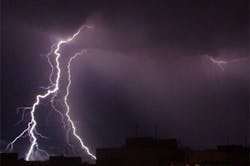Protecting against Mother Nature at sporting events
In recent years, there has been an increased emphasis placed on increasing security at sporting venues across the country. Whether it’s through the installation of security cameras or the use metal detectors, sports leagues want fans to know that they can feel safe when they enter through their gates and rightly so. Who wants to spend their hard-earned money, wait in long lines and sit in traffic, only then to have to worry about some overzealous fan endangering their well-being or that of their family?
Security professionals at these venues obviously spend a significant amount of their time implementing technology, policies and procedures to mitigate against these physical threats. Just last fall, some NFL fans expressed concerns over increased wait times at stadiums due to enhanced pat-down procedures that the league instituted. Security was also increased at Dodger Stadium last year following an attack that hospitalized a fan of a rival baseball team.
One of the biggest threats to fan safety, however, that doesn’t nearly get as much attention, is the danger that is posed by inclement weather. Earlier this week, one person was killed and nine others were injured following lightening strikes at Pocono Raceway in Pennsylvania. According to published reports, fans were warned about the threat of severe weather via the track’s public address systems and through social media.
"We work in conjunction with NASCAR regarding safety of fans, teams and other attendees throughout the course of our race weekends. Additionally, we are in constant communication with local and national agencies regarding weather conditions and emergency services," said Brandon Igdalsky, president and CEO of Pocono Raceway in a statement following the incident. "The safety of all guests to Pocono Raceway is of the utmost importance to our entire staff. This tragic event is at the forefront of all of our thoughts and prayers. We will learn from the incident and continue to implement strategies to help ensure the safety of fans and all attendees at future events at Pocono Raceway."
Ironically, NASCAR President Mike Helton addressed this very issue when he spoke at the National Spectator Sports Security Conference in New Orleans last year. At the time, he said that a tornado striking the site of a Sprint Cup Series event could do as much or more damage than a planned terror attack.
Despite NASCAR or a track’s best efforts to warn fans of impending danger, however, the fact remains that many people still don’t take weather warnings seriously. According to a recent study conducted by Zogby International on behalf of life safety products manufacturer Federal Signal, many Americans are oblivious or apathetic when it comes to taking action on emergency alerts. Less than half of the survey respondents (47 percent) said they would be motivated to take action during a warning of potential severe weather and 33 percent said that they would require actual property damage or injury to care strongly about public safety awareness. In fact, one in 12 people said that nothing would cause them to care.
As most of the fans at Pocono understood when they evacuated, venue safety during weather events has to be a dual responsibility. The facility has a responsibility to warn their guests, and fans shoulder the responsibility to take subsequent action upon receiving those warnings. I think it’s safe to assume that most major stadiums and sporting facilities in the U.S. already have some type of mass notification system in place, so the real challenge is in effectively communicating dangers and getting the audience to respond in kind.
About the Author
Joel Griffin
Editor-in-Chief, SecurityInfoWatch.com
Joel Griffin is the Editor-in-Chief of SecurityInfoWatch.com, a business-to-business news website published by Endeavor Business Media that covers all aspects of the physical security industry. Joel has covered the security industry since May 2008 when he first joined the site as assistant editor. Prior to SecurityInfoWatch, Joel worked as a staff reporter for two years at the Newton Citizen, a daily newspaper located in the suburban Atlanta city of Covington, Ga.

